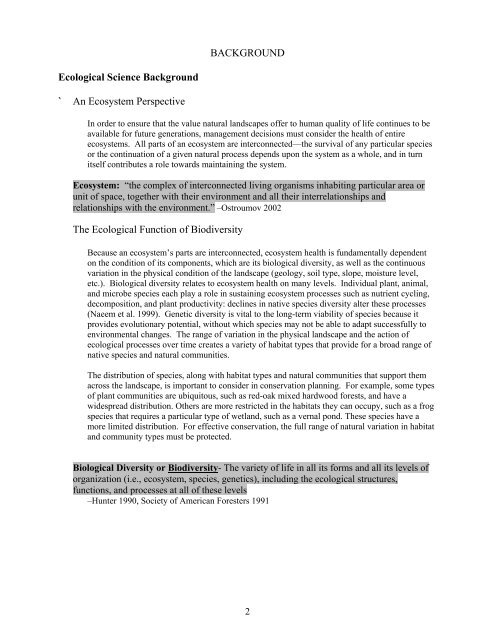introduction - Pennsylvania Natural Heritage Program
introduction - Pennsylvania Natural Heritage Program
introduction - Pennsylvania Natural Heritage Program
Create successful ePaper yourself
Turn your PDF publications into a flip-book with our unique Google optimized e-Paper software.
BACKGROUNDEcological Science Background`An Ecosystem PerspectiveIn order to ensure that the value natural landscapes offer to human quality of life continues to beavailable for future generations, management decisions must consider the health of entireecosystems. All parts of an ecosystem are interconnected—the survival of any particular speciesor the continuation of a given natural process depends upon the system as a whole, and in turnitself contributes a role towards maintaining the system.Ecosystem: “the complex of interconnected living organisms inhabiting particular area orunit of space, together with their environment and all their interrelationships andrelationships with the environment.” –Ostroumov 2002The Ecological Function of BiodiversityBecause an ecosystem’s parts are interconnected, ecosystem health is fundamentally dependenton the condition of its components, which are its biological diversity, as well as the continuousvariation in the physical condition of the landscape (geology, soil type, slope, moisture level,etc.). Biological diversity relates to ecosystem health on many levels. Individual plant, animal,and microbe species each play a role in sustaining ecosystem processes such as nutrient cycling,decomposition, and plant productivity: declines in native species diversity alter these processes(Naeem et al. 1999). Genetic diversity is vital to the long-term viability of species because itprovides evolutionary potential, without which species may not be able to adapt successfully toenvironmental changes. The range of variation in the physical landscape and the action ofecological processes over time creates a variety of habitat types that provide for a broad range ofnative species and natural communities.The distribution of species, along with habitat types and natural communities that support themacross the landscape, is important to consider in conservation planning. For example, some typesof plant communities are ubiquitous, such as red-oak mixed hardwood forests, and have awidespread distribution. Others are more restricted in the habitats they can occupy, such as a frogspecies that requires a particular type of wetland, such as a vernal pond. These species have amore limited distribution. For effective conservation, the full range of natural variation in habitatand community types must be protected.Biological Diversity or Biodiversity- The variety of life in all its forms and all its levels oforganization (i.e., ecosystem, species, genetics), including the ecological structures,functions, and processes at all of these levels–Hunter 1990, Society of American Foresters 19912










